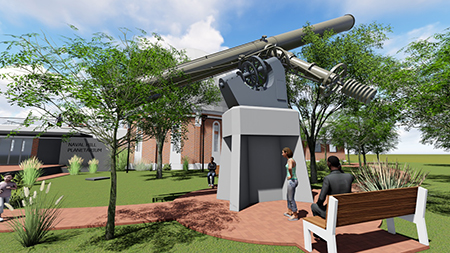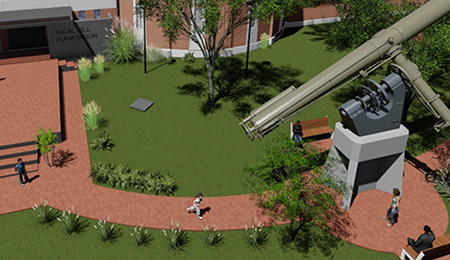08 June 2018
Photo Supplied
 The Lamont-Hussey telescope exhibit together with the completed observing platform and an entrance garden on the grounds of the Naval Hill Planetarium were unveiled recently.
The Lamont-Hussey telescope exhibit together with the completed observing platform and an entrance garden on the grounds of the Naval Hill Planetarium were unveiled recently.

“For my part I know nothing with certainty, but the sight of the stars makes me dream.” – Vincent van Gogh.
Today astronomy enthusiasts can enjoy the sight of the stars from the newly established observing platform at the Naval Hill Planetarium. Also new to the facility is the recently launched exhibit of the historic Lamont-Hussey telescope. Years ago, during the 1920’s, the Lamont-Hussey telescope found its way – through the University of Michigan – to what is now known as the digital Planetarium on the Naval Hill.
Rector and Vice-Chancellor of the University of the Free State (UFS), Prof Francis Petersen, recently launched the telescope exhibit during a celebration of the completed observation platform and the entrance garden on the grounds of the planetarium.
“South Africa hosts some of the major telescopes on Earth and is at the forefront of astronomical research. Today we salute the scientists who have advanced human knowledge and we are proud to be a part of that. We are building on their legacy,” Prof Petersen said.
The telescope, the early days
The 27-inch Lamont-Hussey Refractor was the largest refracting telescope in the southern hemisphere and was used for extensive research in the field of double stars. It was the telescope that was used in what is now the planetarium.
The telescope was named after Prof WJ Hussey, a great astronomer from the University of Michigan and his friend, RP Lamont, a businessman who provided the funds for the construction of an observatory in the southern hemisphere.
Plans for the observatory and a 24-inch refractor began as early as 1910. World War I intervened, and construction of the observatory commenced in 1927. In 1928 the telescope and dome were installed and research began on 11 May of that year.
Dr RA Rossiter (continuing Hussey’s work after he passed away on his journey to South Africa in 1928) started with an eight-year research project in the mapping of double stars. Over 5 000 double stars were discovered by 1937 which grew to 25 000 measurements of double stars in 1947.
In 1971 all observations ended and in 1974 the observatory closed. In 1975 the telescope’s optics were removed and sent back to Michigan, where they are in safe-keeping to this day. In 1976 the University of Michigan gave the building to the Bloemfontein Municipality. Subsequently it was leased to PACOFS and the observatory was used as one of South Africa’s most unique theatres for some time.
The telescope components were preserved by enthusiasts who found the tube and other components of the telescope in the veld outside the fire station in Ehrlich Park in Bloemfontein. The Instrument Division of the UFS and Dukoc Manufacturing refurbished the old telescope components but some missing components were manufactured and with funding from ArcelorMitttal they are now rebuilding the telescope. Although dramatic and beautiful, it will not be a working telescope.
The planetarium, the exhibit
The planetarium, established in the converted Lamont-Hussey Observatory, is a powerful tool for science communication and education and thousands of people attend presentations here each year.
When it opened its doors in 2013, it was the only digital planetarium in the country. Today, South Africa has two digital planetariums, with the second planetarium at the Iziko Museum in Cape Town.
“This project has brought together the UFS, government as well as the private sector. It would not be possible without the continued collaboration and support of all the partners,” said Prof Petersen.